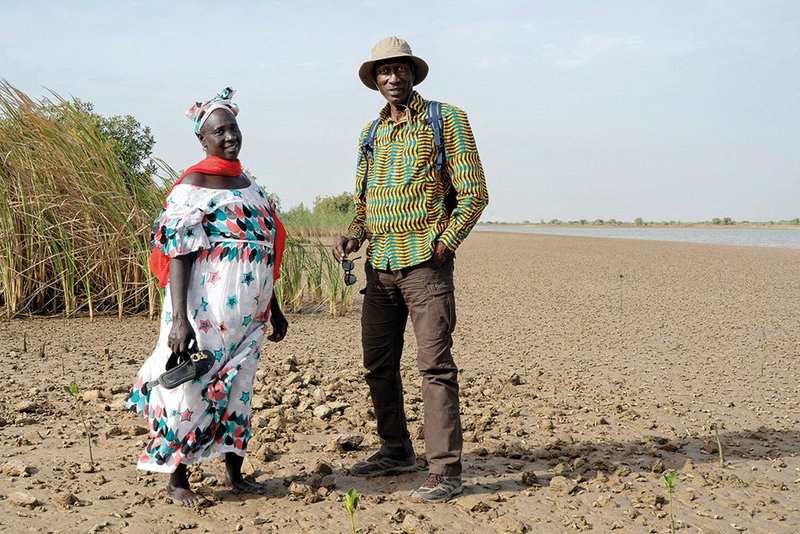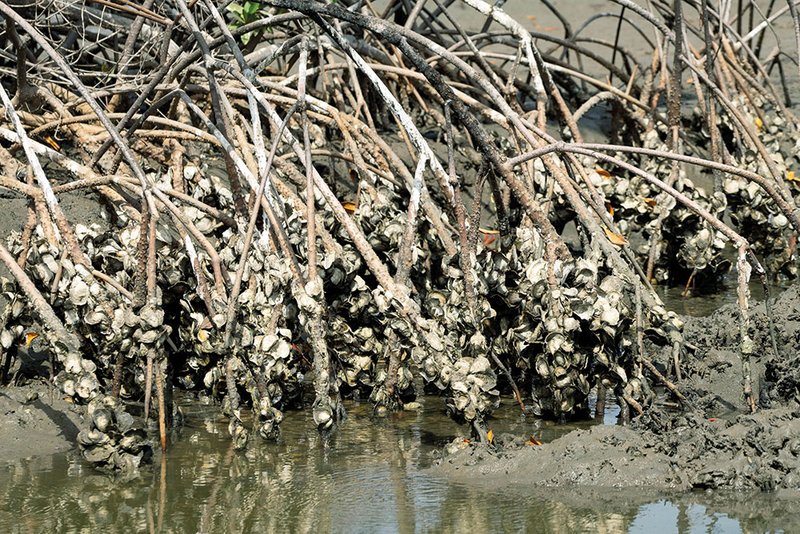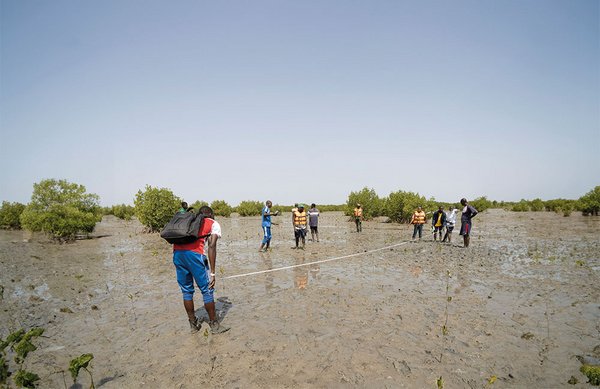 Download this article in magazine layout
Download this article in magazine layout
- Share this article
- Subscribe to our newsletter
Saplings versus sea-level rise
Carrying her sandals, Rama Diop picks her way barefoot through the mud, which squelches in response to every step she takes. Now and again, an empty snail shell crunches beneath her feet. “I enjoy coming here, and come often to check on the mangroves. It makes me happy.” Screeching, a heron takes flight. Rama Diop scrunches her eyes and watches it cross the vastness with a languid motion of its wings and disappear towards the open sea. In the distance, white-crested waves are just in sight. They roll in and break on the beach of this water-dominated landscape. Here in the delta of the Senegal River, it is easy to get disorientated. The ebb and flow of the tides bring constant change. Pools, creeks and lagoons appear and disappear. The Senegal’s spreading torrent keeps finding new ways through the landscape as it makes its way to the Atlantic.
More and more land has been carried away
Some of the Senegal delta is a designated nature reserve. But it still has all kinds of threats to contend with. Nature is being invaded by settlements, roads and bridges. A rising number of fishers overexploit the waters, sometimes also damaging the shoreline zones. But most of all, the water level is rising due to global warming and carrying away more and more land. Whole villages are disappearing. Soils are being salinised. Mangroves could help to prevent this. They break the waves and stabilise the soil. Some mangrove forests are capable of absorbing up to 75 per cent of the energy from waves and storms which would otherwise hit the coast unchecked and with full force. But the mangrove that has been spared the ravages of drought, salinisation and urban sprawl in the last few decades is frequently felled for firewood and timber. Thus, Senegal has lost about 40 per cent of its mangroves in the past fifty years, versus an average loss of 20 to 30 per cent for West Africa.
“In my childhood, mangroves grew thickly all along the shoreline.” Rama Diop gestures to show the wide river branch. Today, most of the open sandy-silty terrain is devoid of vegetation. Seen from the air, the once-dense greenery looks like the fur of a mangy dog. At least, at first sight. Because on closer scrutiny there are rows of thin, finger-length cuttings – small plants of hope. Which is to the credit of the 56-year-old fisherman’s wife. With a group of others from her village, she planted out the cuttings five months ago. Barefoot and bent double, they worked their way forward, always making sure they pushed the plants deep, but not too deep, into the soil and respected the minimum spacing. “Otherwise they don’t grow.”
The gnarled plants with the long roots appear robust. And in a certain way, they are. After all, a mangrove forest is completely inundated with salt water twice a day. Very few of the world’s 70,000 or more tree species can survive that. Indeed, mangrove trees can cope with being immersed for up to one third of the time. But if the sea level rises or a lack of rainfall alters the mix of salty and fresh water, they become stressed. Like all plants they produce oxygen in the course of photosynthesis, but in order to grow they also need to absorb air through their roots. In well-aerated soil with enough sandy particles this is not a problem; in waterlogged mud, it is.
So various things can go wrong when it comes to mangrove reforestation. Seedlings can be trampled down by accident, too, or damaged when the fishers haul their boats ashore. No wonder, then, that Rama Diop is glad to see the long rows of seedlings in good condition. “We need the mangroves – more urgently than ever.” Nobody needs to explain to her the consequences of global warming and rising sea levels. The keen-eyed woman only has to set foot outside the door of her modest home. Her village, Bopp Thior, is on an island across the way from Saint Louis, the former capital of the French colonial period. “My uncle used to live over there.”
Rama Diop points towards the water. No sign of any houses. The river and the ocean swept them away long ago. There is still a plot of land, where Rama Diop used to grow cabbage and tomatoes. But now the soil is salinised and nothing will grow any more. Just like the well that once supplied all the residents of her village with fresh drinking water. Now they have to fetch it once a week by boat from Saint Louis. “And then it’s loaded to the brim with canisters.”
One of the most carbon-rich ecosystems on Earth
Mangroves cannot lower the sea level in the short term. But they do stop the water eroding the coast. They also cool the microclimate and bind greenhouse gases. The United Nations Environment Programme (UNEP) classifies them as one of the most carbon-rich ecosystems on Earth. Healthy mangrove forests can store around 1,000 tonnes of carbon per hectare over thousands of years – far more than tropical rainforests and peatlands.
Like all plants, mangroves bind carbon dioxide from the atmosphere as they grow. What makes such a great difference in mangrove forests is their soil. Every high tide carries in particles from the sea, including carbon-rich particles, some of which get trapped in the root system and eventually sink and compact. These form an oxygen-poor substrate which is the ideal habitat for microorganisms that release sulphur compounds without decomposing organic waste – and thus without releasing greenhouse gases. This makes it all the more dramatic that mangrove forests are under threat, and not just in Senegal and West Africa. Worldwide, only half of the original area of coverage still exists, according to the Mangrove Action Project (MAP), a North American non-governmental organisation.

A strong team supporting mangrove conservation: Rama Diop and Mamadou Mbodji.
In that light, the efforts of Rama Diop and other volunteers to reverse the loss of their local mangroves also take on a global significance. She was prompted to get involved by Mamadou Mbodji from the organisation Naturefriends International. “What happens with the mangroves here is important for you in Europe, too,” he says. The environmental activist is a tall and wiry 66-year-old who grew up in Saint Louis himself.
Passing old houses with crumbling façades, he strides through the narrow alleys of the island of Saint Louis, heading for the beach. Goats are tied up outside the houses. Battered-looking French-built taxis and a surprising number of horse-drawn carriages clatter through the dusty streets. The beach is strewn with colourful fishing boats. In front of it, most of the last line of buildings is now reduced to rubble and ruins. “The sea is coming closer every year. A third of the houses in this district have vanished into the sea already,” says Mamadou Mbodji.
Work started last year down on the beach to build a sea defence from large stones. “Better than nothing. It will delay the disaster somewhat – but a lot more has to happen, otherwise Saint Louis will be lost by 2050.” Mamadou Mbodji’s eyes twinkle behind his tinted glasses. The environmentalist makes no secret of the fact that he considers mangroves the better solution. Funded by donations, he has so far organised the reforestation of 15 hectares in total on various sites in and around Saint Louis.
Not all the plantations are in such idyllic locations as the one on the small sand island where the fisherman’s wife Rama Diop lives. Mamadou Mbodji points out seedlings in bays adjacent to industrial zones, motorways or densely populated residential areas. Some are damaged. “More and more people are coming to Saint Louis, not least because their fields in the countryside are getting salinised.” It means that the pressure is rising constantly, so plantings need to be better protected. People who did so would be helping themselves.
A wealth of species from the air, land and sea come together in mangrove forests. They are home to wild bees and other insects, innumerable species of birds, reptiles, wild cats, oysters, crabs, crustaceans and fish. For many ocean-dwelling creatures, mangrove forests serve as breeding grounds and nurseries. Used sustainably, they provide a good basic food supply for coastal dwellers.
Awareness raising is key
“Replanting alone is not enough. We must convince people to leave the mangrove forests alone or only use them sustainably.” Yakhya Gueye sits under the sunshade of a rocking boat. Squatting beside him on the boat’s benches are scientists and other colleagues from the organisation Wetlands International Afrique. They have already reforested 300 hectares of mangroves here on the Casamance River in southern Senegal. Now they have come equipped with measuring tapes, gauges and other special tools to check on their growth, take soil samples and document pH values.
Apart from reviewing their own work, this could also pave the way for large-scale reforestation and access to the global trade in emissions certificates. The non-governmental organisation has backed its previous reforestation efforts with campaigns and practical guidance on proper use of the wealth of natural resources. For example, oysters attach themselves in rows to the intricate extended root system of the mangroves. Collectors who paddle around the forest in dugout canoes often break the roots right off. “It’s easier for them than pulling off the oysters one by one while balancing in the boat – but it can kill off the mangroves.” This is why Yakhya Gueye and his colleagues are teaching the women how to use wooden racks and ropes to tend and harvest wild oysters.

Oysters attach themselves in rows to the root system of the mangroves. When they are collected, the roots are frequently torn off as well.
Rama Diop has been taught the same near Saint Louis. But her main concern is restoring the mangroves so that the waters eventually hold enough fish again. “Back in the days when everything here was covered in mangroves, my father’s boat was always full of fish when he returned.” She wants it to be that way again. And to make that happen, the resolute fisherman’s wife, who has waded across squelching mud and bent herself double to push seedlings into the ground, would do it all again any time.
Klaus Sieg is a freelance journalist. He writes about agriculture and food, the environment, energy, the economy and social issues. He is based in Hamburg, Germany.
Contact: klaus@siegtext.de





Add a comment
Be the First to Comment